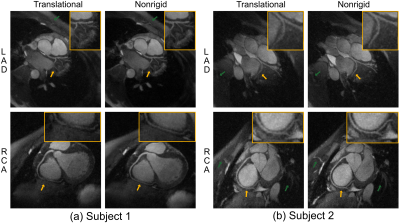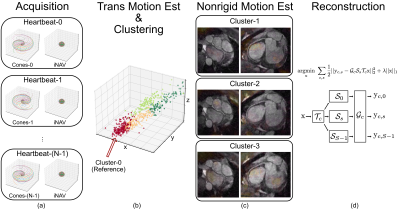Kwang Eun Jang1,2, Mario O. Malavé1, Dwight G. Nishimura1, and Shreyas S. Vasanawala3
1Magnetic Resonance Systems Research Lab (MRSRL), Department of Electrical Engineering, Stanford University, Stanford, CA, United States, 2Department of Bioengineering, Stanford University, Stanford, CA, United States, 3Department of Radiology, Stanford University, Stanford, CA, United States
1Magnetic Resonance Systems Research Lab (MRSRL), Department of Electrical Engineering, Stanford University, Stanford, CA, United States, 2Department of Bioengineering, Stanford University, Stanford, CA, United States, 3Department of Radiology, Stanford University, Stanford, CA, United States
We propose image-space gridding that resamples images onto arbitrary grids, which provides a pair of operators that represents the forward and adjoint of a nonrigid transform. This allows existing nonrigid image registration techniques to be incorporated into model-based reconstructions.

Figure 4. Reconstructed slices near LAD and RCA. The proposed method exhibited improved sharpness not only near the coronary arteries (orange arrows) but also in non-cardiac regions (green arrows) compared to 3D translational motion-corrected reconstruction.

Figure 1. Overview. (a) For each heartbeat, we collect segmented cones interleaves that sparsely cover the entire k-space along with another set of cones interleaves for the 3D iNAVs. (b) 3D translational motion is estimated using the iNAVs. Segmented cones data from individual heartbeats are binned to reconstruct image-based self navigators. (c) Nonrigid motion is estimated using an existing image registration method. (d) The nonrigid motion-corrected reconstruction is achieved by solving an optimization problem using image-space gridding operators.
